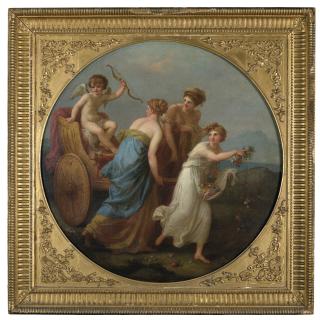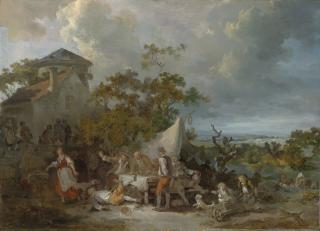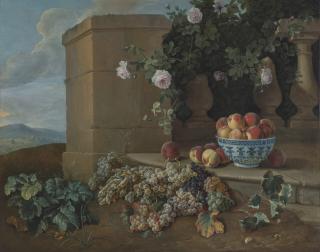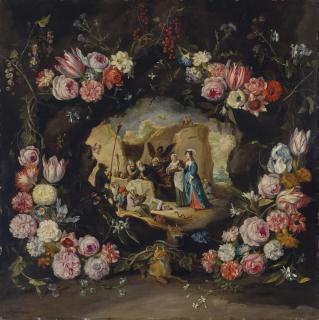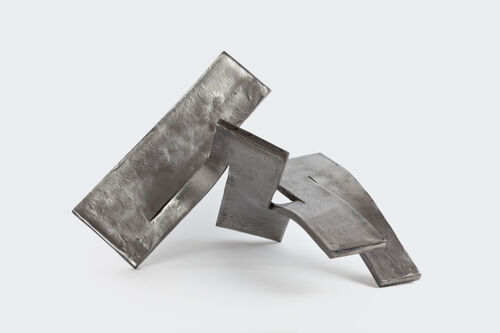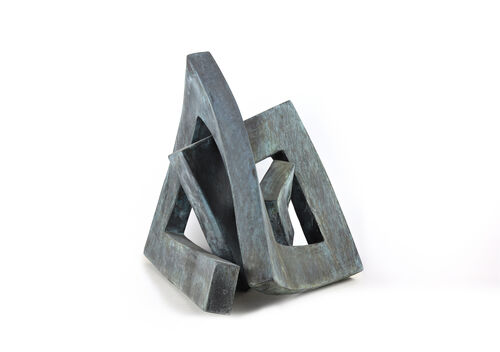Angelica Kauffmann, R.A.
Le Triomphe De L'Amour
Found at
Christies,
New York
Maîtres Anciens : Peintures - Sculptures - Dessins, Lot 31
15. NOV - 15. NOV 2023
Maîtres Anciens : Peintures - Sculptures - Dessins, Lot 31
15. NOV - 15. NOV 2023
Estimate: 25.000 - 35.000 EUR
Price realised: 81.900 EUR
Price realised: 81.900 EUR
Description
ANGELICA KAUFFMANN, RA, THE TRIUMPH OF LOVE, SIGNED, OIL ON A CIRCULAR CANVAS LAID DOWN ON A SQUARE CANVAS
The present painting is part of an important cycle dedicated to love, of which our work represents the sixth and final stage: the triumph of Cupid. The little god is seated on a chariot pulled by two graces, his bow raised exultantly to the sky. A third grace walks at the head of the procession, strewing the path with flowers.
The other five works in this cycle are held by the Vorarlberg Landesmuseum in Bregenz (inv. nos. Gem 1346-1350). The museum also holds a preparatory drawing for the Triumph of Love. Interestingly, all the paintings were originally executed on circular canvases and were subsequently laid down on square canvases.
The Triumph of Love is the conclusion of the story that begins when Cupid tries to blind Aglaia, one of the Three Graces, with his magic so she will fall in love. To avenge their sister, Aglaia's companions join forces to steal Cupid's quiver. Cupid manages to recover it, however, and to punish them he strikes them all with his arrows. Love has taken its revenge. This is a cycle that explores the conflict between reason and love, between chaste love and passionate love. In this final episode, grace, joy and beauty, personified by the Graces, bow before passion, despite their brief victory, which spoke to a more platonic love. Here, Kauffmann pays homage to his panegyric moniker 'pittrice delle grazie' [painter of grace].
This cycle was very popular in the 18th century. It was commissioned by the English publisher Henry Bryer (d. before 1783), who sought to make a substantial profit by distributing an engraved version. In collaboration with the engraver and publisher William Wynne Ryland (1738-1783), he had the set engraved between 1777 and 1779 by the Russian Gabriel Scorodomoff (1748-1792), one of the finest engravers of his time. The text on the engravings specifies that Bryer was the owner of the first, third and fifth scenes of the painted cycle. The engraving of the present painting (fig. 1) does not mention the name of an owner but includes a dedication to the Russian princess Yekaterina Romanovna Dashkova (1743-1810). This does not necessarily imply that she owned our painting, but a letter from the craftsman Matthew Boulton to the Princess requesting permission to reproduce her work as a 'mechanical painting' suggests that she acquired The Triumph of Love from Bryer before January 1778, the date of the print's publication, thus justifying the absence of Bryer's name from the caption. The date of publication also indicates that the painting was executed no later than 1777.
We would like to thank Dr. Bettina Baumgärtel, head of the Angelica Kauffman Research Project, for examining the painting and contributing her detailed expertise to the writing of this note. The painting will be included in the artist's catalogue raisonné that is currently in preparation.
- Possiblement commandé par Henry Bryer (mort avant 1783), Londres. | Possiblement dans la collection de la princesse Yekaterina Romanovna Dashkova (1743-1810), née comtesse Vorontsova, avant janvier 1778. | Possiblement dans la collection de John Arnold Wallinger (mort en 1792), Hare Hall, Essex (selon W. Angus, 1787, op. cit. infra). | Vente anonyme, Sotheby's, Londres, 12 mars 1980, lot 70. | Collection particulière, Suisse ; puis par descendance à l’actuel propriétaire.
The present painting is part of an important cycle dedicated to love, of which our work represents the sixth and final stage: the triumph of Cupid. The little god is seated on a chariot pulled by two graces, his bow raised exultantly to the sky. A third grace walks at the head of the procession, strewing the path with flowers.
The other five works in this cycle are held by the Vorarlberg Landesmuseum in Bregenz (inv. nos. Gem 1346-1350). The museum also holds a preparatory drawing for the Triumph of Love. Interestingly, all the paintings were originally executed on circular canvases and were subsequently laid down on square canvases.
The Triumph of Love is the conclusion of the story that begins when Cupid tries to blind Aglaia, one of the Three Graces, with his magic so she will fall in love. To avenge their sister, Aglaia's companions join forces to steal Cupid's quiver. Cupid manages to recover it, however, and to punish them he strikes them all with his arrows. Love has taken its revenge. This is a cycle that explores the conflict between reason and love, between chaste love and passionate love. In this final episode, grace, joy and beauty, personified by the Graces, bow before passion, despite their brief victory, which spoke to a more platonic love. Here, Kauffmann pays homage to his panegyric moniker 'pittrice delle grazie' [painter of grace].
This cycle was very popular in the 18th century. It was commissioned by the English publisher Henry Bryer (d. before 1783), who sought to make a substantial profit by distributing an engraved version. In collaboration with the engraver and publisher William Wynne Ryland (1738-1783), he had the set engraved between 1777 and 1779 by the Russian Gabriel Scorodomoff (1748-1792), one of the finest engravers of his time. The text on the engravings specifies that Bryer was the owner of the first, third and fifth scenes of the painted cycle. The engraving of the present painting (fig. 1) does not mention the name of an owner but includes a dedication to the Russian princess Yekaterina Romanovna Dashkova (1743-1810). This does not necessarily imply that she owned our painting, but a letter from the craftsman Matthew Boulton to the Princess requesting permission to reproduce her work as a 'mechanical painting' suggests that she acquired The Triumph of Love from Bryer before January 1778, the date of the print's publication, thus justifying the absence of Bryer's name from the caption. The date of publication also indicates that the painting was executed no later than 1777.
We would like to thank Dr. Bettina Baumgärtel, head of the Angelica Kauffman Research Project, for examining the painting and contributing her detailed expertise to the writing of this note. The painting will be included in the artist's catalogue raisonné that is currently in preparation.
- Possiblement commandé par Henry Bryer (mort avant 1783), Londres. | Possiblement dans la collection de la princesse Yekaterina Romanovna Dashkova (1743-1810), née comtesse Vorontsova, avant janvier 1778. | Possiblement dans la collection de John Arnold Wallinger (mort en 1792), Hare Hall, Essex (selon W. Angus, 1787, op. cit. infra). | Vente anonyme, Sotheby's, Londres, 12 mars 1980, lot 70. | Collection particulière, Suisse ; puis par descendance à l’actuel propriétaire.
Upper estimate price exceeded by more than 100%
This artwork by Angelika Kauffmann achieved an unexpectedly high price at Christies in New York in November this year. In the Maîtres Anciens : Peintures - Sculptures - Dessins auction, the work Le Triomphe De L'Amour sold for EUR 81,900.00 - well above the upper estimate of EUR 35,000.00. Of course, this price has nothing to do with the top prices that other works by Angelika Kauffmann achieve. The highest price we have observed so far was reached by the work Portrait Of Mary May (1745-1824) With Her Three Daughters; And Portrait Of Joseph May (1730-1796) With Their Three Sons in December 2013 with an auction result of GBP 1,106,500.00 (€ 1,330,947.89).
Oberer Schätzpreis um mehr als 100% übertroffen
Dieses Kunstwerk von Angelika Kauffmann erzielte im November diesen Jahres bei Christies in New York einen unerwartet hohen Preis. In der Auktion Maîtres Anciens : Peintures - Sculptures - Dessins wurde die Arbeit Le Triomphe De L'Amour für EUR 81.900,00 versteigert – und damit weit über dem oberen Schätzpreis von EUR 35.000,00. Dieser Preis hat freilich nichts mit den Spitzenpreisen zu tun, die andere Arbeiten von Angelika Kauffmann erzielen. Den höchsten von uns bisher beobachteten Preis erreichte die Arbeit Portrait Of Mary May (1745-1824) With Her Three Daughters; And Portrait Of Joseph May (1730-1796) With Their Three Sons im Dezember 2013 mit einem Auktionsergebnis von GBP 1.106.500,00 (€ 1.330.947,89).







